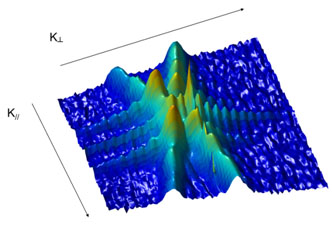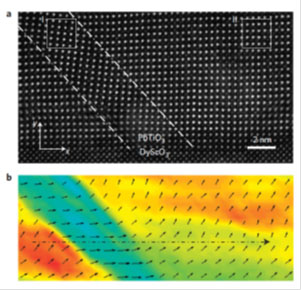Published in Nature Materials: Ultra-thin piezoelectrics for energy harvesting
Piezoelectric materials can transform mechanical energy into electrical energy and vice versa. Because of that they are used in a multitude of everyday applications from gas lighters to inkjet printers and from ultrasound generators in medical applications (echography devices, blood sensors, lithotripters) to vibration dampers (in cars, skis, helicopter blade).
However, piezoelectric materials have the potential to play an even greater role in society by harvesting the energy that is wasted ubiquitously as vibrations (from cars, house appliances, industrial machine) and transforming it into electricity. But in order to fulfil our dream of paving roads, railways and homes with piezoelectrics, these materials have to be made lighter, thinner and less toxic than the ones available today (which contain heavy chemical elements). An important step into this direction has been achieved by a team led by Beatriz Noheda (Zernike Institute for Advanced Materials) and in collaboration with the Mesa+ Institute of the University of Twente, the CIN2-Barcelona and the CEMES-CNRS Institutes in Toulouse and Zaragoza. The results have been published in Nature Materials.
Flexoelectricity
The researches have shown that ultra-thin films (with thickness of about 100 atomic layers) of piezoelectric materials deposited under carefully designed conditions, self-organize and flex at the nanometer scale in periodic fashion. This produces huge strain gradients (large differences in the distances between atoms) in such a way that a new mechanism to produce piezoelectricity can take place (so-called flexoelectricity). This greatly increases the materials response at these small thicknesses. Moreover, this novel way of producing piezoelectricity is less dependent on the chemical composition and will allow non-toxic and more readily available materials to be investigated for piezoelectric energy harvesting application.
Prof. Beatriz Noheda is Associate Professor of Functional Nanomaterials and Rosalind Franklin Fellow. In 2004 she received a NWO Vidi-grant.
Reference: Flexoelectric rotation of polarization in ferroelectric thin films, G. Catalan, A. Lubk, A. H. G. Vlooswijk, E. Snoeck, C. Magen, A. Janssens, G. Rispens, G. Rijnders, D. H. A. Blank and B. Noheda. Nature Materials.
DOI: http://dx.doi.org/10.1038/NMAT3141


| Last modified: | 24 August 2021 09.21 a.m. |
More news
-
01 April 2025
NSC’s electoral reform plan may have unwanted consequences
The new voting system, proposed by minister Uitermark, could jeopardize the fundamental principle of proportional representation, says Davide Grossi, Professor of Collective Decision Making and Computation at the University of Groningen
-
01 April 2025
‘AiNed’ National Growth Fund grant for speeding adoption of AI at SMEs
Professor Ming Cao receives an ‘AiNed’ Growth Fund grant of EUR 2.4 million for research that will contribute to faster adoption of AI at SMEs in the technical industry in the Netherlands.
-
01 April 2025
'Diversity leads to better science'
In addition to her biological research on ageing, Hannah Dugdale also studies disparities relating to diversity in science. Thanks to the latter, she is one of the two 2024 laureates of the Athena Award, an NWO prize for successful and inspiring...
